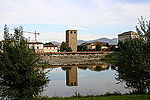Monastero delle Murate

Monastero delle Murate (Monastery of Murate) is a former Benedictine convent on Via Ghibellina in Florence, Italy. For about a hundred years, from 1883 to 1985, it was the men's prison in Florence, after which the detainees were transferred to Sollicciano and other facilities. Since the 21st century, it has served as a restaurant and meeting places, with additional apartments, bars, restaurants and shops. The religious community dates to 1370 when 12 women became voluntarily reclusive in a shack by the second pillar of the Ponte Rubaconte (Ponte alle Grazie), praying and living on alms in extremely difficult conditions. Given the growth in the number of sisters, in 1424, Giovanni de 'Benci, who lived nearby, financed the construction of a new, larger monastery near the walls, called the Most Holy Annunciation and St. Catherine. The monastery was renovated and expanded for the first time in 1471, following a fire, and then in 1571, after a flood. Supporters included Lorenzo de' Medici. Also in 1509 Caterina Sforza was buried in the monastery.
Excerpt from the Wikipedia article Monastero delle Murate (License: CC BY-SA 3.0, Authors, Images).Monastero delle Murate
Piazza della Madonna della Neve, Florence Quartiere 1
Geographical coordinates (GPS) Address Nearby Places Show on map
Geographical coordinates (GPS)
| Latitude | Longitude |
|---|---|
| N 43.769094 ° | E 11.268686 ° |
Address
Piazza della Madonna della Neve 7
50121 Florence, Quartiere 1
Tuscany, Italy
Open on Google Maps










